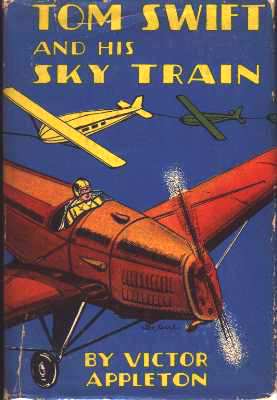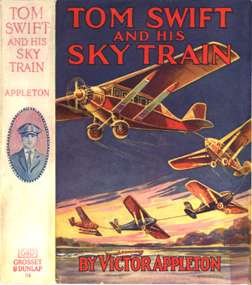
Tom Swift and his Sky Train
Or, Overland through the Clouds
By Victor Appleton
Summary:
No official summary was ever provided with any of the old Tom Swift books. However, the plot can be summed up as follows:When the book opens, Tom Swift is working hard on his latest invention, the Sky Train (see description below). However, working on the Sky Train isn't as easy as it could be -- first his experimental sky train crashed, and then the bank denied a crucial loan, and then his Sky Train crashed again (into the greenhouse of the irate president of his bank!), and then it almost crashed again. Could it be sabotage?
If this wasn't bad enough, the Acton firm is sponsoring another, rival Sky Train in hopes of beating Tom Swift to the market. A World Exposition in which airplanes feature highly is to be held in San Francisco shortly, and both want to be the first to be there. In fact, it blossoms into a race: on a certain date at a certain time both Sky Trains are to take off, and whoever gets to San Francisco first will receive a huge amount of money -- money Tom Swift can't afford to lose.
Who is behind the sabotage, if it is indeed sabotage? Will Tom Swift win the prize? It's all there, in Tom Swift and his Sky Train.
![]()
Major Inventions
(The image below is from the collection of James D. Keeline)

There is one major inventions in this book, and that is, of course, the Sky Train. The Sky Train is just what its name implies -- a train that files. The design of the train is simple: at the front of the vehicle is a large and powerful plane. Coupled to this large and powerful plane is a number of simple, large-capacity gliders. The idea is this: the main engine of the plane stays in the sky permanently, except for maintenance (it's refueled in mid-air, I believe). Smaller planes tow the gliders into the sky and then let them go; skillful pilots position the planes to where the couple grabs them and they are fastened. To let a plane go, the couple is simply de-coupled, and the glider gently "volplanes" down to earth.
The reason such a design was commercially practical was because of the airplanes of the time. In the 1930's, when this book was written, airplanes were small, slow, and could hold relatively few people. Building a 777 and filling it with 400+ people was completely out of the question -- the designers of the time just couldn't handle the load. Getting from coast to coast could take quite a while, especially with several-hour stops and delays. Having more passengers added and taken off in mid-air, while the airplane was still flying along, saved people enormous amounts of time.
Tom, therefore, found an easy way: simply take one powerful, fast airplane, a number of gliders, and hook them together. Over a city, drop a glider or two off here, pick up a glider or two there. I know that it sounds ridiculous, but one has to remember what airplanes were like in the old days.
The Sky Train, of course, was never built. Planes are fantastically powerful now, and are capable of hauling passengers from England to Australia in one flight. Such a grand and complex scheme as the Sky Train simply isn't needed. Still, one wonders. What if the Germans hadn't looked into designing the jet engine? Had things turned out differently, we just might have built a Sky Train.
Some portions of the book that talked about the mechanical aspects of the Sky Train are:
"Huh! Sky train! Sounds foolish to me, but go on!"
"Well, it isn't quite as foolish as it may sound," Tom said, trying to keep his temper. "As you probably have heard, there is to be held, shortly, on the Pacific coast one of the biggest air meets in history. I have sent some exhibits out there and I am planning to send another, my big dirigible, Sliver Cloud. All those are perfected inventions -- they all work -- and so does my experimental sky train÷"
"In brief, my sky train will consist of a powerful airplane, of a cabin typer, capable of carrying say a score of passengers," Tom said. "If this was all there was to it I wouldn't be troubling you. But while planes carrying passengers from coast to coast are not uncommon, my plan of attaching to the towing plane a number of smaller planes, without motors, which are called gliders, is new. And my plan of having the towing plane pick up gliders, filled with passengers, at various flying fields between here and the coast, and taking them along, dropping them off as a railroad train drops off coaches at local points, is also new."
"Do you mean to say," burst out the bank president, "that you propose to fly a train of gliders through the air, starting here in the east, pick up other gliders at intermediate points, dropping off some, picking up others and like that?"
"That's exactly what I propose to do," said Tom, smiling.
"It can't be done!"
"Excuse me, but it has been done," Tom said. "I have just come from a test of my new invention. You realize, Mr. William, that it is comparatively easy for a towing plane to start from the ground, towing motorless gliders -- any reasonable number of them. But by my plan, the last glider in the train can be cut loose at any determined point, and will go down to the ground say at Chicago, Denver, or any place between here and the Pacific coast."
"You mean you just cut loose those gliders filled with passengers and let the drop?" asked Mr. William. "That's foolishness! Dangerous! They'll all be killed."
"No," went on Tom. "The Gliders will land as gently as any regular airplane. Each glider will be in charge of a competent pilot who will ease it down to earth. But that is only of my plan. I want to make my coast to coast sky train a sort of express, without stops. And I plan to have it pick up loaded gliders at certain points and pull them out to the coast."
"You mean you're going to dip down in that big airplane of yours, with a string of gliders for a tail, like a kite, and hook on to some other glider, or gliders, waiting on the ground? That can't be done! There would be a grand smash! You needn't think I'll lend you money on such a wild scheme!"
"You don't quite understand," Tom went on, patiently. "I don't propose to pick up gliders from the ground with my sky train. The glider, or gliders, at intermediate points, filled with passengers, will be hauled into the air by an auxiliary motored plane at each landing field, and will be coupled to the rear of my sky train while it is in full flight."
÷"Let me see if I get you, he said to Tom. "You propose to start a sky train, consisting first, of a big motored air[plane, say from New York, and head for San Francisco. Towed by the big plane will be several gliders, carrying passengers. One glider will have in it passengers who, we'll say, want to land at Chicago. When your sky train gets there, you'll drop off the last glider. Is that it?"
"I won't exactly drop it off," Tom said with a smile. "I will simply uncouple it, as a brakeman would uncouple a railroad coach from the rear of a train. The glider, guided by a pilot, will make the landing safely. At the same time an auxiliary-motored plane on the Chicago field will soar aloft, towing a glider of passengers who want to go to San Francisco. The glider will be coupled to the rear of my sky train in place of the one lef off over Chicago, and the plane that brought it up will circle back to the field."
"Well, I can understand the principle of the thing," grudgingly admitted the bank president. "It sounds all right in theory and I'll admit that we're getting to be quite an air-minded country. But will your plan work and will it pay?"
"It will work," said Tom, with more confidence than he felt since the accident. "And I'm sure it will pay. There is a growing demand for rapid transportation between here and the Pacific Coast,"
"Yes, I admit that. But a sky train! All nonsense, I should say!"
÷
"Yes. You know, up to now, and before, the tail glider could be released by either the pilot in it or by me, or some one else in the hauling plane. That is, after a signal was given. But this was the weak spot in my invention. You see, I, or someone in the plane, might forget to give the signal, and cur the glider loose, or the pilot in the glider might do the same thing. But with dual double control it isn't possible."
"Why not?"
"For the same reason you can't open your bank safe deposit box all by yourself. A clerk from the bank has to turn half the lock with his key, and you, or he, has to turn the other half with your key. You can't get in with your key alone and the bank clerk can't get in with his key alone. It means dual double control and makes for safety."
"Now if I can change this magnetic coupler a bit, no glider can get loose from my sky train until the pilot in the glider and the pilot, or some responsible party in the same plane, act in concert. That will end all accidents, I think."
÷
The descent of the sky train glider was the signal for the plane on the ground to start upward with its glider in tow. Getting off to a good fine start in the wind, the small plane rapidly gained height and speed until it was flying after the Eagle that now had but one glider in its "tail."
"The idea," Tom explained to Ned, "is for the lifting plane to come after us, and a little above, regulating her speed until she is flying evenly with us, keeping her glider on a level with our rear one. Then she gradually goes a bit faster until the nose of the raised glider couples to the tail of the other glider. As soon as contact is made the plane cuts loose, zooms up and goes back to the ground."
÷
![]()
Tom Swift and His Big Dirigible | Tom Swift and His Giant Magnet | Back to the Index